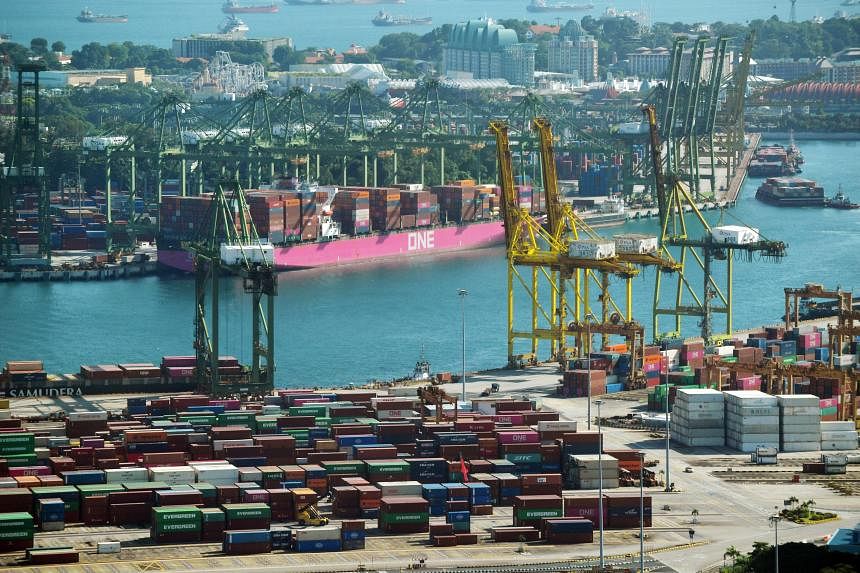SINGAPORE – Singapore’s key exports slipped back into contractionary territory in December, driven by continued weakness in shipments of electronics and slower growth in pharmaceuticals.
Non-oil domestic exports (Nodx) fell 1.5 per cent from a year ago, data from Enterprise Singapore (EnterpriseSG) showed on Jan 17. This is below analysts’ expectations of growth, with Bloomberg’s consensus forecast at 3 per cent. In November, Nodx had briefly entered positive territory after a 13-month decline, logging a 1 per cent increase.
These results mean that Singapore’s full-year Nodx contracted 13.1 per cent in 2023 from the previous year – its worst annual showing since 2001, say economists. They expect the Republic’s export recovery going forward to be “gradual and fragile”, and “somewhat bumpy in the near term”.
Exports of electronics fell by 11.7 per cent in December from a year ago, improving slightly from a 12.8 per cent contraction in November. Electronics shipments, which form about a fifth of Singapore’s Nodx, have seen 17 straight months of decline.
Personal computers, which constitute nearly 10 per cent of electronics Nodx, were a key driver of December’s decline. Their exports dropped by 34.3 per cent from a high base a year ago.
Integrated circuits (ICs), or semiconductors, which comprise about half of electronics Nodx, were also a contributing factor. But their exports contracted by just 7.9 per cent – the IC sector’s slowest pace of decline since the third quarter of 2022, said DBS Bank economist Chua Han Teng, attributing the improvement to a recovery in global semiconductor sales.
Conversely, exports of non-electronics grew by 1.4 per cent year on year. This marks a second straight month of growth, but a drop from the 5.2 per cent increase recorded in November. The dip is due largely to a slower pace of growth in the typically volatile exports of pharmaceuticals, which grew 56.9 per cent year on year – down from 118.9 per cent in November.
Exports to Singapore’s top 10 markets declined as a whole, led by falls in exports to Taiwan, South Korea and Japan. But shipments to China, Hong Kong, the European Union and the United States rose, with exports to the EU growing 8.6 per cent – reversing the previous month’s decline of 21.7 per cent.
“Demand conditions from the major economies appear to be steadying, but regional demand conditions still look slightly shaky for now,” said Ms Selena Ling, chief economist and head of global markets research and strategy for OCBC Bank.
UOB senior economist Alvin Liew and associate economist Jester Koh said the US, China and the EU grew their share of Singapore’s Nodx in 2023, while that of some Asean economies fell. Notably, the US overtook China to become the Republic’s top Nodx destination for the full year of 2023, accounting for 17 per cent of these exports.

Economists expect that Singapore’s Nodx will return to positive growth in 2024, on the back of a low base in 2023 and a nascent recovery in demand for electronics.
One forward-looking indicator that signals better days ahead for the Republic’s overseas shipments is the purchasing managers’ index (PMI), said DBS’ Mr Chua.
New export orders in the manufacturing PMI improved for the seventh straight month in December, staying above the 50 mark that indicates expansion, he noted.
UOB’s Mr Liew and Mr Koh said the electronics PMI also suggests an impending recovery in the electronics sector, with a second consecutive expansionary reading in December.
The outlook for 2024, however, remains tempered by external risks and uncertainties.
“The global economic environment remains uncertain due to high interest rates in advanced economies, a bumpy recovery in China and lingering geopolitical tensions that could disrupt supply chains,” said Mr Chua.
Ms Ling said: “The near-term Nodx outlook still looks slightly challenging from the global supply chain angle.” She cited complications like the ongoing tensions in the Red Sea and the Israel-Hamas conflict in making her prognosis.
Maybank economists Chua Hak Bin and Brian Lee said in a report that December’s surprisingly weak Nodx performance could have been aggravated by supply chain disruptions from the Red Sea tensions and the drought in the Panama Canal, which have led to delays and a rise in logistics costs.
EnterpriseSG in November predicted that Singapore’s Nodx will grow between 2 per cent and 4 per cent in 2024.

